Of Home, Anisa and Cowboy Boots
Martinstor, Freiburg-im Breisgau. My photo. December 14, 2012.
Preface:
This is one of the last of my two-years of conversations with Tante Hilde, so I’m starting backwards with what is freshest in my mind, and, frankly with the tape that popped up first. This transcription and translation took me a while; my German is not as good as I like to think it is. The blog has no conclusion. Really it’s the first half of the transcription, and I couldn’t figure out how to tie it all together.
* * *
Anyone entering Hilde’s apartment during our conversations would have heard a series of cacophonic sounds, exaggerated facial expressions, and flapping of arms, all conducted by two nicely dressed women within the small, neat, orderly apartment we were in. These wild attempts to make up for our language gaps would be accentuated by strong guttural or high-toned intonations–Hilde’s emphatic “Euh?” to see if I understood what she meant, or my “Ah…. ja, ja!” as my slow moving German-infused brain cells finally opened up all my memory drawers to figure out what the words she was using actually meant. Often all these extra-verbal cues became necessary because, as we got more and more into the topic, we would start interrupting each other–not a good thing for an interviewer like me to do. All of this was punctuated by what can only be described as wild waves of laughter, each building on the previous one, cresting at an extended guffaw, followed by sighs as we caught our breaths, then hesitant “um” and “euh” sounds as we tried to remember where we had left off.
When I first came to the College of Wooster, around 2000, the “office” four doors down from mine (I was hired late, so my office had until recently been a janitor’s closet, but that’s another story) housed an enormous floor to ceiling cage within which restlessly screeching capuchin monkeys were housed so Psychology majors could do behavioral projects on them. This usually seemed to involve ringing little bells at interval around noon, when several of us were working in our offices. Our theory was that the students were pretending to study the effects of little noises on monkeys while actually performing tests on us. The monkeys would get particularly loud when someone brought them their favorite treat–Captain Crunch cereal; then they would get very quiet as they focused on taking out their favorite marshmallow bits. Something like that comes to mind as I think back on my lively conversations with Tante Hilde.
The monkeys in their newer home, still at the College of Wooster. The thirty-year old female, Jake, is munching on candied popcorn here. (The original group was supposed to be only male, so they were surprised when a baby popped out of Jake. This is after all a Psychology, not a Biology department.) http://www.ohio.com/news/local pub. June 15-June 30, 2014. June 15, 2015.
The setting, however, was much more “cozy” than caged, even as, it seems, Tante Hilde felt a bit caged in by this small, somewhat isolated space.
Part One: Tante Hilde’s Spaces
I am struck by the way that Tante Hilde’s living spaces–like those of so many people (including myself, I’m sure, in a few years)–have kept shrinking with diminishing energy levels, the latter being something which Hilde was actively angry about in a refreshing way–as if she were getting ready to attack some alien being who was maliciously draining energy from her.
When I first visited Tante Hilde, in 1968 (when I was twelve), the Stotz family was clearly thriving. Tante Hilde, Onkel Fred, and five strapping, healthy, exuberant children, ranging from teens through their twenties were–most of them–living in a spacious two-story house (spacious if you didn’t have five children) near the center of Freiburg and right off the tram line. Yet the place struck me as calm and welcoming. As a twelve-year-old I don’t remember much, but the entrance way (shown below with my parents and Tante Hilde around 1968) gives a sense of the kind of house that it was–solid, comfortable, enclosed yet welcoming.
Entrance to the Stotz house around 1968; taken by Onkel Fred, I believe. The photograph is from Tante Hilde.
The house in 2011. My photo. August 19, 2011.
By the time I visited Tante Hilde in the winter of 2012, she had moved to a small but comfortable one-bedroom apartment just a bit further out, with a tidy, miniature back yard, complete with the neighbor who always seems to come with these yards–the one who, to Hilde’s annoyance, let her dog wander into her yard and mess about the garden. While complaining about the neighbor and catching me up about her family, Hilde served me my father’s (and my) favorite wurst–frankfurters–with sauerkraut. I was delighted and relieved, sharing my father’s apprehension about eating some of the more strong-flavored and oddly (for me) textured German wurst.
Tante Hilde in her back yard. There’s a story about the dog; all I remember is that he was a gift, and that she cherished him. Photo taken by me on August 19, 2011.
This visit taught me how my mother and Tante Hilde had been unlikely candidates for a close friendship, even as working on the puzzle clarified why they were such close friends. My mother, cosmopolitan and college-educated, from a prestigious family in Cuba and engaged to an American Yale graduate; Tante Hilde, from Berlin but having lived most of her life in Freiburg-im-Breisgau, from a solid middle class family and married to a clock-maker. My mother, well off enough at Vassar to send care packages after the war; Hilde the recipient of packages. Yet, once they met, their friendship was strong enough that, after my father died, they would meet in Germany and spend a week or so at a spa together.
One year–towards the end of the Clinton era when there was an easing up of travel to Cuba–I asked my mother if she wanted to go back to Cuba that summer. Mami’s response was, “Ay no–porqué? I am going to visit Tante Hilde in August.” And, to quote my mother quoting A. A. Milne, “That, said John, is that.”
A strong sense of family was one of the things over which my mother and Tante Hilde bonded; jigsaw puzzles were another. Every year my mother would send Tante Hilde a puzzle and Tante Hilde would return the favor. The ones from Tante Hilde would arrive around Christmas time with German cookies–the kind you can get easily now (chocolate pretzel shaped cookies; little crescent-shaped shortbreads with sugar coating, or little wafers with sweet creamy stuff in the middle), but were unusual, even exotic, for us then. The puzzles that accompanied the cookies were often a landscape associated with the Black Forest, and we would get working on it often on Christmas day itself. Little by little, those who came by for our Christmas Open Houses would find themselves working on the puzzle, at times to the frustration of my father who had been hoping to discuss jet propulsion engines with the guests.
When I visited Hilde in 2011, she had been working on a puzzle from Mami for a long period of time. Hilde’s eyesight–no longer strong–made it difficult for her to make out the nuances in the pieces that would give her a hint about which piece fit where. Perhaps her greatest satisfaction at having me visit was the fact that, with her, I was able to make quite a bit of progress with the puzzle. The puzzle itself escapes me now, although I remember bright, big yellow flowers and lots of blue.
Life may have seemed somewhat confining at this point, but Tante Hilde still drove her little car about, and she still went out for dinner. My first night I came to see her in 2011, she suggested that we meet for dinner at the Schwarzwälder Bauernstube, part of the Gausthaus zum Kreuz where I was staying, just outside of Freiburg in the village of Kappel–the same place where the travelers had stayed for a month in 1949.
The Gasthaus zum Kreuz. 1949. Postcard found in Mami’s attic.
A recent image of Gasthaus zum Kreuz. http://www.alt-freiburg.de/kappel01.htm. n.d. June 15, 2015.
The restaurant specializes in traditional Black Forest fare, beautifully prepared, with some nods towards those, like me, whose favorite food is not necessarily meat. And it’s run by the same family (a generation or so later) as the family that was running it when my mother, Anisa, Joan and Carmen were there in 1949.
That evening I wandered into the Gasthaus restaurant, suitcase in hand, foggy from the train trip and a somewhat nervous car rid to Kappel (getting used to German cars and German driving), looking for someone to tell me how to get to the little gasthaus next door, which looked provisionally abandoned, and there was Tante Hilde, elegant, and energetic in a bright-flowered dress. Her welcoming smile and shout of “Terry!” immediately made up for all the travel fatigue, as did, soon thereafter, the lovely regional wine (A discovery! Excellent regional German red wine), the fresh pasta dish, and the pleasure of Michael arriving–Hilde’s second son–towards the end of dinner. At that point our table was fluttering with people stopping by to say hello. There’s no doubt that Michael–a forester living near by–was well known there, so that soon I felt enveloped in warm breaths, buxom women in dirndls, and the dark wood interior.
* * *
When I returned in 2013, Hilde was no longer driving, and she had moved to a cute but tiny efficiency at the edge of Kappel, complete with a red bedroom/living, a small kitchen/dining area, and a storeroom, all close enough to Michael that he could look after her from his forester’s demesne further into the Black Forest. Her mobility and energy had diminished she remained amazingly vigorous for her age, alert with that bird-eyed sharpness, even if she seemed to tire more easily than she had before.
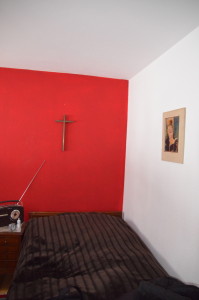 Hilde’s Kappel apartment. Photo taken by me, December 14, 2012.
Hilde’s Kappel apartment. Photo taken by me, December 14, 2012.
Hilde had issues with the place–mainly because it was so small , but it had a wonderful, resonant red wall and a storeroom for her puzzles.
Hilde’s collection of jigsaw puzzles. Kappel, My photo. December 14, 2012.
Also of concern for Hilde was the fact that her apartment was a bit north of the center of Kappel, an area with no streetlights, leaving her feeling quite alone, even abandoned, at night. And, in fact, I tried to make my way there the first night, but got stopped by darkness, and disorientation, the latter in part because Hilde had referred to one of the landmarks as a large cross, but there are so many large crosses in Kappel, that it was hard to keep straight which large cross, exactly, Hilde was referring to.
That was fine, though–except for missing Hilde that first night. It was a cold, crisp, clear evening, and, beyond the streetlights, the snow brightened the way; no cars came by; the only sound was the crunch of my footsteps through gravel and a little iced snow. The astonishingly bright constellations in the sky brought me back to the fairy tale Germany of my youth.
* * *
When I saw Tante Hilde last summer, in 2014, her world had become at once smaller and larger. She had moved to an assisted living facility, within which she has a miniature bedroom–enough room for a bed, a table, and, essentially in a closet, a toilet and sink. On the other hand, the room is in a larger building, complete with showers, cafeteria, recreation rooms, and clinic, all on a hill at the top of a densely green, beautifully maintained park with a gorgeous view of greenery, the river, and people walking with their kids. While the building is a bit “retirement homeish” on the inside (blah paint on walls, meh flooring, practical institutional-type furniture) it has a quite pleasant café and balcony with real (i.e. non-institutional-type) food. I had ate a sweet creamy cakey concoction, which made me happy and a bit sleepy.
Tante Hilde likes the place–she’s certainly happier here than she was in her little room in the Black Forest, but she feels a kind of confinement from friends and family–the loss of friends and even children to death, the inability of her old friends, including Maria, to come and visit her, her hearing loss–which makes communication with friends more difficult, and the fact that she feels most of the inmates with her are suffering from Alzheimer’s, something she has, blessedly, not experienced, despite being well into her nineties.
But, in the winter of 2012, the setting for this conversation was the miniature apartment in the Black Forest at the edge of the small town of Kappel. Tante Hilde, if I recall correctly, sat on a chair, while I was on the bed. After my usual self-consciousness about putting the tape near Tante Hilde, we settled in for a nice chat. I’d already had the official conversations with her, so this chat had no strong agenda.
I was, as always, grateful for Hilde’s precise enunciation of her German words. According to my mother, I should be grateful that Hilde is from the Berlin area, since the Black Forest area is not exactly known for careful enunciation. And we stirred in English with German as needed, making up for gaps in communication with giggling, and dramatic gestures that opened up the walls of her micro-apartment to a larger world.
Part Two: American Footwear and Adolescence
The scene begins as I looked back to our last chat a year earlier, when Michael and his partner Gisela had taken us for a drive in the Black Forest. Hilde and Gisela sat in the backseat comfortably chatting with each other, and I heard bits of a story Hilde was telling about my mother’s visit in 1949.
(Throughout, Hilde is speaking in German; I am attempting to speak in German.)
Terry: So, um, you told Gisela–that I owned (it was supposed to be “I heard”, but I was a bit tired and was getting my German words confused) that my mother had cowboy boots?
Hilde: Ja, your mother–well, your grandmother–had brought the cowboy boots for my eldest son; there were three–Peter and… (holding her fingers up to start counting)
Terry (interrupts): and Peter wanted… and she from London to Paris to…
Hilde (interrupts; steering wheel motion): everywhere the cowboy boots, and what I remember is your grandmother driving that Citröen all the way from Paris. I cannot explain the face he had when he saw the boots. Your grandmother also brought cacao, sugar.
 The famous Citröen. Tante Hilde’s photo. 1949.
The famous Citröen. Tante Hilde’s photo. 1949.
** *
A bit later, after discussing eating habits and baths (more of which in the next blog), American footwear returned, only this time Hilde was referring to an event that happened in, perhaps, the 1980’s, at Hilde’s granddaughter’s–Ulli’s–confirmation.
Hilde: And I will never forgive Ulli for her behavior (strong finger waving here). Your mother told me about it.
Terry (leaning forwards in anticipation): Ah, ja?
Hilde: Erzählen?
Terry: Uh hunh (slowly remembering what “erzählen” means)
Hilde: Your mother invited Ulli to choose a special restaurant in Hannover, so that your mother could take her out to dinner there.
Terry: Mmmmm.
Hilde: And then, Ulli answered–she answered “I’d rather have in-line skates.”
Terry: Ja, because she was what–sixteen years old?
Hilde: Yes, but nevertheless… [got a bit hard to hear here, as Hilde’s gestures got in the way of the microphone, not to mention the fact that we were interrupting each other and I’m laughing all the time.] … her upbringing.. no, that simply won’t do. It’s as if…
Terry (eager to defend Ulli): But my mother, she likes to…
Hilde (leaning forward and shaking her finger): Aber… ne, ne, ne, ne, ne, ne, ne. Your mother wouldn’t have told me if it didn’t bother her… Eh?
Terry: Yeh… (said in English–more laughter) Mmmmm. Ah! Ah ja, but you know, she probably didn’t even know what “inline” means.
I assume that Ulli got the inline skates, and, certainly that both Mami and Ulli (who is now in her 30’s) are well past thinking about the skates. But not Tante Hilde.
Ulli, August 9, 2014, in a different “white dress” occasion. My photo.
* * *
Inevitably the conversation led to the way that teenagers don’t change, no matter what the generation.
Hilde: Ah, ja… Christa was the same way when she was younger.
Terry: Uh, huh?
Hilde: She was always reacting against me–totally against me. And in the mornings at breakfast–what a face! I would say, “Krista, why do you hate me?” “Hate”–do you know what that means?
Terry (nodding): Jaaaah….ja, ja.
Hilde: That came back to me when she, later, would complain to me about Ulli!
Terry: Jaaaaah! She’s complained to me as well.
Hilde: Do you see? Do you see? It’s always the same.
Terry (hesitantly picking her words in German): When I was younger–a teenager–
Hilde: When … you?
Terry: Yes, with my mother, … I…when I was eighteen, there were always problems.
Hilde: And let me be honest here, bringing up young boys, was never a problem.
Terry: mmmhhh, ja, and ….Maybe. But, I don’t know; I only have one son.
Hilde: One… yes. You have no problems with him.
Terry: No. I … uh …
Hilde: Ja…
Terry: Charles can …
Hilde: …. the usual problems
Adolescent Charles (my photo). December 23, 2011
Terry: …He is … ja…
Hilde: Puberty. (said in English).
Terry: Ja … and Charles could–um… work more…
Hilde (vigorously nodding; probably thinking of her sons): Ja, ja, ja, ja.
(Terry laughs hysterically)
Hilde: ja, ja, ja, ja, ja … und and clean up his room.
Terry: yes; but we are very … um … he is very …. um … nice.
Hilde (leaning forward with emphasis): Unclutter your desk!
Terry (thinking of the rather grotesque pile of stuff on Charles’s desk at school, including ancient food): Ja! but it’s like all teenage boys.
Part Three: Anisa and Friendship
If American footwear and adolescence were a source of pleasure and conflict for Tante Hilde, Anisa was a strong focus of interest for her, partially, I think, because of her “exotic” background, partially because Hilde had met her, and partially because Anisa was only in Freiburg for one night, having to leave the next day to return to New York in order to start her M.A. in Public Policy at Columbia University.
Hilde: But what I didn’t know was that one of the travelers was “eine arabisches mädchen.” So, I was guessing where she was from–an American? from London? from East Germany? And, tell me, where did Anisa meet her husband–in England?
Terry: No. In Iraq.
I told Hilde much of the narrative that Anisa had generously passed on to me. How she left Iraq after life became difficult once the Americans toppled the government of Saadam Hussein and how Tala had persuaded her parents to stay in London. Hilde then asked whether Anisa’s husband had been in the Iraqi army, and I explained that he had been a plastic surgeon, and that Tala is married to an Iraqi architect.
What was interesting throughout is how much Tante Hilde deeply cares for Anisa, despite not knowing her very well at all.
Hilde: I imagine that Anisa is sometimes homesick.
Terry: Mmmm, Ja; ja.
Hilde: (in English) Long time; ja?
I mentioned how Anisa was also worried about her sister, who was still living in Iraq and how she had gone to meet her sister in Jordan and, hopefully, find her a place there, particularly as her sister is somewhat ill.
Terry: Anisa is 85 years old but is still somewhat strong.
Hilde: Aaaahhh (with, I think, some envy here).
Terry: She can still travel.
Hilde: And is Anisa flying there?
Terry: Yes, she’s there now. And it’s good for Anisa; the weather is nice there right now. She’ll be there for two months.
Hilde: Ah, so.
We spent a bit more time on the friendships that have resulted from the four travelers’ children.
Terry: So, what’s great is that Anisa’s son lives in the same city as my husband’s parents.
Hilde: In England? (probably confused by my bad German)
Terry: In Milwaukee. In Wisconsin. The son. The daughter lives in England. And the son is a doctor for children; pedia?
Hilde: (meditatively): Pediatrician (Kinderarzt), Ja….
Terry: He is, um, …
Hilde: In England.
Terry: No–in Milwaukee, Wisconsin. And what’s great is that I’m friends with Joan’s son.
Hilde: Ah! But Joan is no longer alive?
Terry: Nein, nein, nein. She is … many … many … but her son–I’m friends with him.
Hilde: Jaaaah….
Terry: And he’s also friends with my husband, Tom.
Hilde: Aaaaaah!
Terry: Because …
Hilde: What a coincidence!
I went on to explain how we’d met Mark Janeck at my parents’ house, as he was working in D.C. and we were in graduate school nearby.
By this time Hilde seemed to be getting tired, and I decided it was a good time and spend an afternoon as a tourist in Freiburg, so we called it a day.
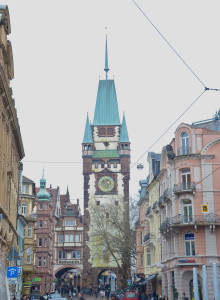
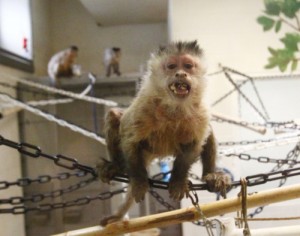
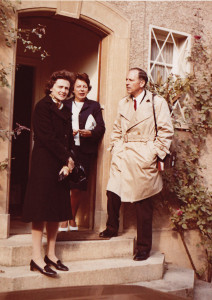
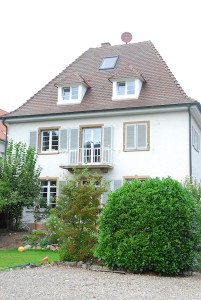
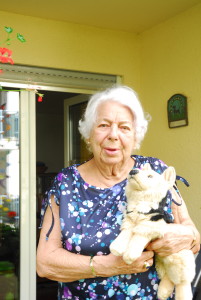
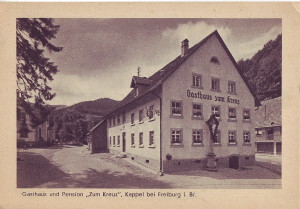
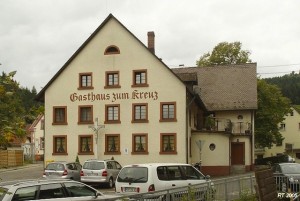
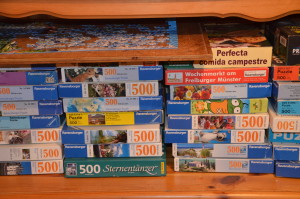
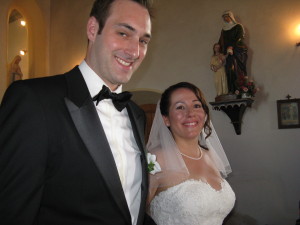
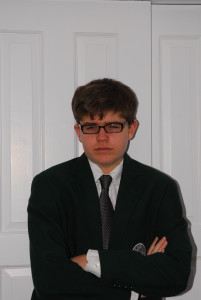
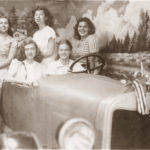
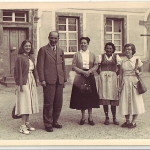
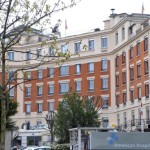
Recent Comments